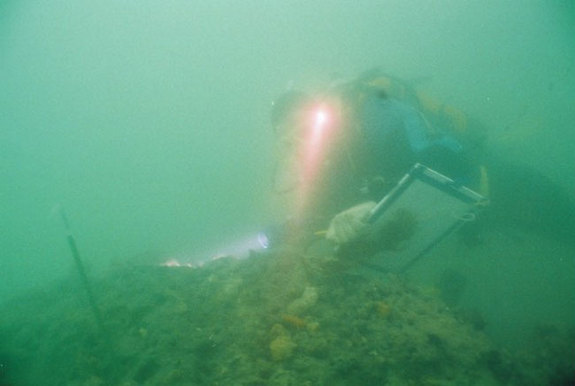It looks like you're using an Ad Blocker.
Please white-list or disable AboveTopSecret.com in your ad-blocking tool.
Thank you.
Some features of ATS will be disabled while you continue to use an ad-blocker.
share:
Today...
I'd like to pop in and post a couple of recent finds that on the surface may appear to be unrelated but if one were to consider the time frames being discussed are telling a story of ancient man from two different perspectives. First up....
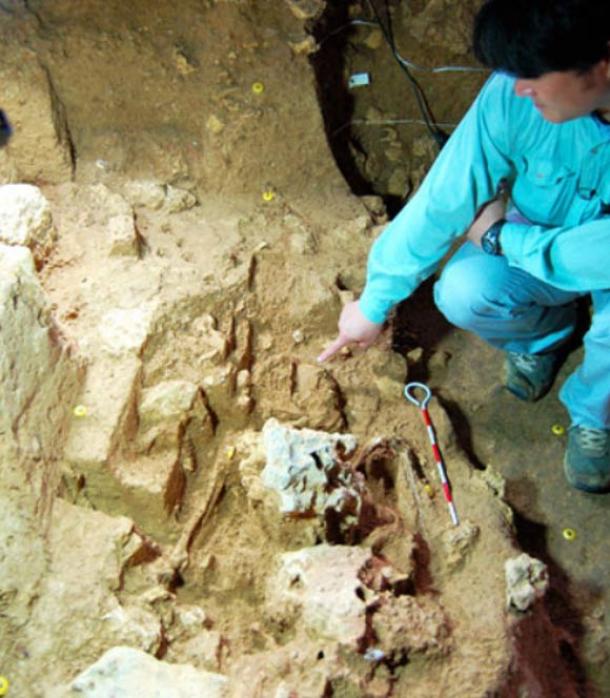 9,000-year-old human remains may shed light on prehistoric Okinawa -
9,000-year-old human remains may shed light on prehistoric Okinawa -
I feel this helps to put things into better perspective on how ancient coastlines were swallowed up as sea levels rose from the last of the last of the ice age melt offs. These 'Islands' were probably at the time connected then later, the oceans rose effectively making mountaintops into islands.
To bolster this we then have the following from Down under...
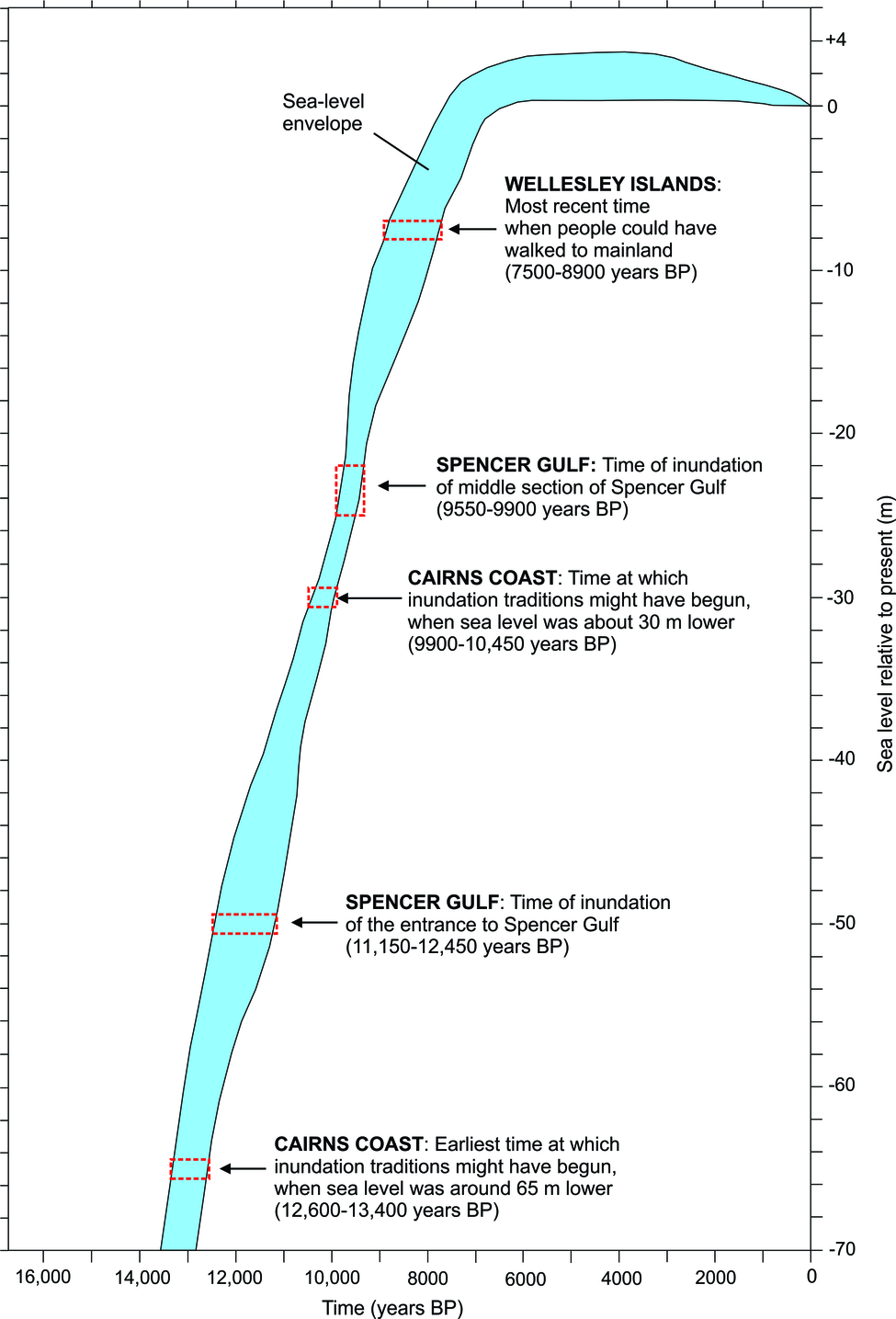 Ancient Aboriginal
stories preserve history of a rise in sea level
Ancient Aboriginal
stories preserve history of a rise in sea level
For me, The idea of Ancient Pacific mariners and even earlier explorers or migrants from South East Asia and all other points West is not out of the realm of speculation. Like many places around the globe these sea level rises in Human history could be the source for the 'Great Flood" myth, just over time have been embellished and exaggerated...
What of the stories of Ancient cultures (now submerged) by the well documented sea levels rises of the past?
Thought to chew on, is it not possible that along those now submerged coastlines are the remains of either lost early Civilizations or advanced cultures?
All throughout the Pacific seems to be signs of such early explorations and development. Were the Polynesians truly the first prolific Pacific seafarers?
What of Aboriginal remains found in South America etc....
I'd like to pop in and post a couple of recent finds that on the surface may appear to be unrelated but if one were to consider the time frames being discussed are telling a story of ancient man from two different perspectives. First up....

Human bones as old as 9,000 years have been unearthed on the Japanese island of Okinawa. Researchers hope they will help elucidate what people’s lives and burial practices were like in the Paleolithic era of Okinawa....
Previously bones as old as 32,000 years have been found on the island chain of Okinawa. The bones unearthed most recently date to the Jōmon Culture, which existed between 12,000 and 1,700 years ago. The Jomon culture is known for its pottery. Until recently it was thought the people of that time and place got their food by hunting and gathering, but recent research has found they also did some domestication of plants and animals.
I feel this helps to put things into better perspective on how ancient coastlines were swallowed up as sea levels rose from the last of the last of the ice age melt offs. These 'Islands' were probably at the time connected then later, the oceans rose effectively making mountaintops into islands.
It is not clear when humans came to inhabit the islands but fossil human bones from the Yama#a-cho Cave 1, excavated in Naha City, have been positively dated to 32,000 years ago and, in Gushigami-son village, the remains of the Minatogawa people have been dated to 17,000 years ago. These Paleolithic humans are thought to have crossed over on a land bridge from continental China but exact details remain unknown.
To bolster this we then have the following from Down under...

Around Australia, we know that at the coldest time of the last ice age about 20,000 years ago, sea level stood about 120 metres below its present level. When the last ice age began to end, a few thousand years later, huge masses of ice that had built up on the land, particularly in the northern hemisphere, began melting. Water poured into the world’s oceans, raising their levels in ways that are now well understood. By about 13,000 years ago, sea level had risen to around 70 metres below its present level. One thousand years later, it had risen to about 50 metres below present. These dates give us a ballpark for how old stories of flooding may be. Could they have reached us from 13,000 years ago?
For me, The idea of Ancient Pacific mariners and even earlier explorers or migrants from South East Asia and all other points West is not out of the realm of speculation. Like many places around the globe these sea level rises in Human history could be the source for the 'Great Flood" myth, just over time have been embellished and exaggerated...
What of the stories of Ancient cultures (now submerged) by the well documented sea levels rises of the past?
Thought to chew on, is it not possible that along those now submerged coastlines are the remains of either lost early Civilizations or advanced cultures?
All throughout the Pacific seems to be signs of such early explorations and development. Were the Polynesians truly the first prolific Pacific seafarers?
What of Aboriginal remains found in South America etc....

Stone Age Settlement Found Under English Channel
The site, just off the Isle of Wight, dates back 8,000 years
Burnt wood fragments gouged with cut marks and a layer of wood chippings were found lying under 35 feet of water during the latest dig.
Stone Age Settlement found under English Channel
Erosion on the floor of the English Channel is revealing the remains of a busy Stone Age settlement, from a time when Europe and Britain were still linked by land, a team of archaeologists says.
The vast majority of ancient sites underwater would probably be in scuba diving range. There are so many complications with being underwater a major leap forward is required in the technology of submarine archaeology. If we could do it from the internet with drones . . .
Mike Grouchy
a reply to: mikegrouchy
Yeah I posted a related article a few years back here at ATS.
Seems, as time passes more and more details are being revealed.
Stay tuned.
Yeah I posted a related article a few years back here at ATS.
Seems, as time passes more and more details are being revealed.
Stay tuned.
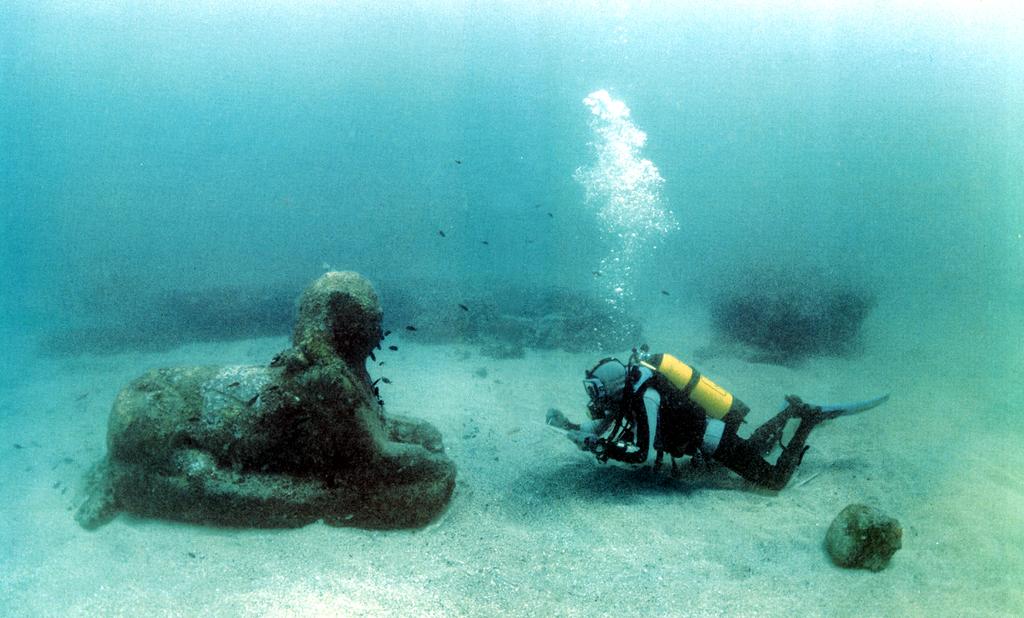
I wonder what something like an 8,000 year old bronze age site in the English channel does to some of the migration theories, and something else. Who invented the boat. I've heard a lot of academic discussion about the wheel, but when was the boat "invented"/discovered. Sometimes I look at pictures like this sphinx and wonder if it didn't fall off a boat. How far back does that possibility go? The interesting thing about the 8,000 year old site is that it is a road.
Mike Grouchy
a reply to: mikegrouchy
The Sphinx is made out of a top of a mountain that is buried in sand.
So it is carved out of solid limestone. The Head tho is made of solid Granite. But is Melded with the body. If the head was made of limestone too it would of surely crumbled by now.
The Sphinx has underwent many restorations.
I imagine at once point it had an outer caseing that was removed by vandles looking for Treasure. Exposing the limestone to Eaten away.
I also recall the Sphinx having wings at one point as well. But they broke off a long time ago.
The Sphinx is made out of a top of a mountain that is buried in sand.
So it is carved out of solid limestone. The Head tho is made of solid Granite. But is Melded with the body. If the head was made of limestone too it would of surely crumbled by now.
The Sphinx has underwent many restorations.
I imagine at once point it had an outer caseing that was removed by vandles looking for Treasure. Exposing the limestone to Eaten away.
I also recall the Sphinx having wings at one point as well. But they broke off a long time ago.
a reply to: mikegrouchy
Boats have been around for quite a long time. Neanderthal definitely used boats to get to islands in the Mediterranean like Crete and Malta and its highly probable the H. Erectus were the first sea faring people as their remains or tools have been found in places like Soctora which is an island 150 miles off the Horn of Africa and 240 miles from Yemen. Even with lower sea levels were talking about an island so far off the coast that it wouldn't have been visible from land. This indicates not just the intelligence to build and navigate open seas, which would have been fairly high and in line with H. Neanderthalensis and possibly our own, but also a creative and imaginative process for them to even be able to consider what might be out there out of the line of sight. That tools found on Soctora are dated between 500,000 and 1 MYA which is pretty incredible when you put it into context.
Boats have been around for quite a long time. Neanderthal definitely used boats to get to islands in the Mediterranean like Crete and Malta and its highly probable the H. Erectus were the first sea faring people as their remains or tools have been found in places like Soctora which is an island 150 miles off the Horn of Africa and 240 miles from Yemen. Even with lower sea levels were talking about an island so far off the coast that it wouldn't have been visible from land. This indicates not just the intelligence to build and navigate open seas, which would have been fairly high and in line with H. Neanderthalensis and possibly our own, but also a creative and imaginative process for them to even be able to consider what might be out there out of the line of sight. That tools found on Soctora are dated between 500,000 and 1 MYA which is pretty incredible when you put it into context.
originally posted by: SLAYER69
Thought to chew on, is it not possible that along those now submerged coastlines are the remains of either lost early Civilizations or advanced cultures?
I think of that thought quite often, actually. When looking at the map that mikegrouchy posted, it's no wonder that there is such a blank space in the history of humanity. I get excited to think about the time when exploring these ancient coast lines will be economically feasible and people will be doing it because of an increased thirst for the knowledge of our past. Disappointingly, I don't see that coming anytime soon.
The flood accounts/myths have always intrigued me, because most cultures--even "disconnected" cultures--have them as part of their collective memory, and they had to occur. The only question in my mind concerns whether or not they're all talking about the same even, or different localized-but-widespread floods that they only believed encompassed the entirety of the globe.
Very interesting stuff, and I really wish I had the answer.
The 13'000 BP date is the one that makes most sense to me when considering "lost" civilizations as it is towards the end of the glacial melt period
- this would have given time for areas to develop before being engulfed.
However, given that time frame, is does raise other concerns. Primarily, the location of possible sites are generally in areas that suffer greatly from tidal factors. For example, Gulf of Arabia, Tip of India / Sri Lanka, Ganges delta, Southern Japan, Gulf of Mexico / Caribbean, West Coast Britain. How much would be left or recognisable after 13'000 years under the tip of India?
West Coast Britain also fascinates me - there are writings (usually from early British Monks writing "mythical" accounts) that suggest that the Isles of Scilly were once land locked and the land inhabited - as that area is regularly battered by North Atlantic swells, i honestly cannot imaging much if anything surviving 13'000 years.
However, given that time frame, is does raise other concerns. Primarily, the location of possible sites are generally in areas that suffer greatly from tidal factors. For example, Gulf of Arabia, Tip of India / Sri Lanka, Ganges delta, Southern Japan, Gulf of Mexico / Caribbean, West Coast Britain. How much would be left or recognisable after 13'000 years under the tip of India?
West Coast Britain also fascinates me - there are writings (usually from early British Monks writing "mythical" accounts) that suggest that the Isles of Scilly were once land locked and the land inhabited - as that area is regularly battered by North Atlantic swells, i honestly cannot imaging much if anything surviving 13'000 years.
a reply to: peter vlar
Dont' forget fish hooks near Papua New Guinea dating to 40'000 years ago (of a size only useful for Deep Sea fishing).
Dont' forget fish hooks near Papua New Guinea dating to 40'000 years ago (of a size only useful for Deep Sea fishing).
a reply to: mikegrouchy
I have no evidence for this but i strongly favour the idea that boats originated in the Northern Climes. Why? Early boats tend to be more sea worthy the further North they are found.
Although a much later period in time, when Caeser conquered the Venetti rebellion, they were an ocean going tribe. The rebellion was crushed by building a fleet of triremes and sailing down river to assualt their coastal bases - which the Romans admit only worked because everything went in their favour. They stated that Venettian boats were much better constructed than anything Rome could offer and were deeper and wider (better for ocean going journeys rather than hugging the coast). They were much more stable and much more manouverable.......and disappeared following the crushing of the rebellion (entire tribe either slaughtered or sold into slavery as a warning to other tribes of the fate of those who rebel).
I have no evidence for this but i strongly favour the idea that boats originated in the Northern Climes. Why? Early boats tend to be more sea worthy the further North they are found.
Although a much later period in time, when Caeser conquered the Venetti rebellion, they were an ocean going tribe. The rebellion was crushed by building a fleet of triremes and sailing down river to assualt their coastal bases - which the Romans admit only worked because everything went in their favour. They stated that Venettian boats were much better constructed than anything Rome could offer and were deeper and wider (better for ocean going journeys rather than hugging the coast). They were much more stable and much more manouverable.......and disappeared following the crushing of the rebellion (entire tribe either slaughtered or sold into slavery as a warning to other tribes of the fate of those who rebel).
originally posted by: Flavian
a reply to: peter vlar
Dont' forget fish hooks near Papua New Guinea dating to 40,000 years ago (of a size only useful for Deep Sea fishing).
I'm not familiar with any finds that old in New Guinnea but there is certainly evidence of boat based fishing in East Timor dating to ~42,000 BP. The oldest fish hooks ever discovered were associated with this find. One was dated to 11,000 BP and the second and older hook was dated to 16-23,000 BP. There were copious remains of fish like Tuna that aren't normally caught anywhere near shore and the Abundance of bones would indicate there were quite certainly boats used for these endeavors. The reason I didn't mention it when discussing the earliest evidence of boats was that this site is clearly associated with fully developed modern humans whereas the instances I mentioned were from earlier members of our genus with evidence going back at least a half a million years for ocean going craft. Its still pretty important though as these are the oldest fish hooks ever found and the associated remains prove that boat based fishing was occurring at least twice as far back as the hooks found as well as very long term use of the cave by humans. The consistent 30,000 year time span for use of the cave for cleaning and cooking of fish is pretty impressive in my opinion and shows that these people were more sedentary and less of a roving hunter gatherer culture.
a reply to: SLAYER69
Not anything new, but repeating pathologist claims for how emigrants came from Asia to North America when a land bridge exited.
As others mentioned, boats helped pave the wave way like this walrus-skin eskimo boat:
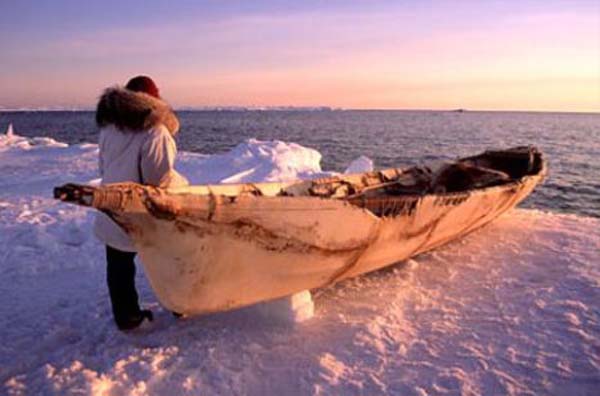
and this seal-skined boat:
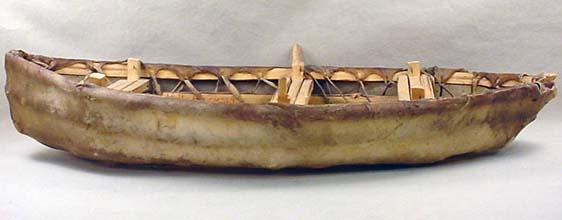
Not anything new, but repeating pathologist claims for how emigrants came from Asia to North America when a land bridge exited.
As others mentioned, boats helped pave the wave way like this walrus-skin eskimo boat:

and this seal-skined boat:

Hi slayer,
thanks for posting that,
There are for sure unknown coastal cultures, but "civilizations" not so much, they would have left some traces inland well away from the shoreline. And we have found those traces, among the solutrean sites in europe, and the channel island finds in CA, even though they were a sea fairing people we find their traces at upland sites well away from the water.
No the polynesians were not the first, by a long shot.
The polynesians were the last to come to the game in the pacific, as far as indigenous sea fairing people go. In fact the polynesian question has roots in the subject of your OP.
The easy and safe theory of the Lapita being the for runners of the polynesians is about as valid as the classic out of africa ideology, its hooey. Although the ancient lapita were distantly related to the modern polynesians, they split from the same austronesian source more than 8k years ago.
The Lapita populated all of oceana and remote oceana, and well into western polynesia.
and
That last sentence illustrates some of the things in that discussion that dont make any sense. But thats is for another discussion
As to that dont think Austrailians, but think more "undiferentiated early human", because we know that after people settled australia other than going on to tasmania, they didnt leave the continent, if they did they left no cultural traces as they made their way around the pacific rim. But there is evidence that at the end of the last ice age, people from the new world back migreted into the old world, and there is some tantalizing evidence to the fact, that is often ignored because it is so hard to explain.
thanks for posting that,
originally posted by: SLAYER69
Today...
What of the stories of Ancient cultures (now submerged) by the well documented sea levels rises of the past?
Thought to chew on, is it not possible that along those now submerged coastlines are the remains of either lost early Civilizations or advanced cultures?
There are for sure unknown coastal cultures, but "civilizations" not so much, they would have left some traces inland well away from the shoreline. And we have found those traces, among the solutrean sites in europe, and the channel island finds in CA, even though they were a sea fairing people we find their traces at upland sites well away from the water.
All throughout the Pacific seems to be signs of such early explorations and development. Were the Polynesians truly the first prolific Pacific seafarers?
No the polynesians were not the first, by a long shot.
The polynesians were the last to come to the game in the pacific, as far as indigenous sea fairing people go. In fact the polynesian question has roots in the subject of your OP.
The easy and safe theory of the Lapita being the for runners of the polynesians is about as valid as the classic out of africa ideology, its hooey. Although the ancient lapita were distantly related to the modern polynesians, they split from the same austronesian source more than 8k years ago.
The Lapita populated all of oceana and remote oceana, and well into western polynesia.
Other scholars like J. Allen located the origin of the Lapita complex in the Bismarck Archipelago that was first colonised 30,000 to 35,000 BCE. Others see obsidian trade as the motor of the spread of Lapita-elements in the western distribution area.
and
'Classic' Lapita pottery was produced between 1350 and 750 BCE in the Bismarck Archipelago. A late variety might have been produced there up to 250 BCE. Local styles of Lapita pottery are found in Vanuatu and New Caledonia. Pottery persisted in Fiji, whereas it disappeared completely in other areas of Melanesia and in Siassi.
In Western Polynesia, Lapita pottery is found from 800 BCE onwards in the Fiji-Samoa-Tonga area. From Tonga and Samoa, Polynesian culture spread to Eastern Polynesia areas including the Marquesas and the Society Islands, and then later to Hawaii, Easter Island, and New Zealand. However, pottery-making did not persist in most of Polynesia, mainly due to the lack of suitable clay on small islands.
That last sentence illustrates some of the things in that discussion that dont make any sense. But thats is for another discussion
What of Aboriginal remains found in South America etc....
As to that dont think Austrailians, but think more "undiferentiated early human", because we know that after people settled australia other than going on to tasmania, they didnt leave the continent, if they did they left no cultural traces as they made their way around the pacific rim. But there is evidence that at the end of the last ice age, people from the new world back migreted into the old world, and there is some tantalizing evidence to the fact, that is often ignored because it is so hard to explain.
a reply to: punkinworks10
Thank you...
I wasn't aware of Lapita and there possible link to California and Chumash Indians.
Source
More reading on Chumash SantaYnez Tribe
Thank you...
I wasn't aware of Lapita and there possible link to California and Chumash Indians.
Source
Where these formidable navigators came from has been debated for years. One model is that the Lapita originated in Taiwan and traveled south and east to New Guinea, then out into the Pacific islands. An alternative is that about 3,500 years ago various aspects of the Lapita--people, language, and culture--came together in Indonesia, then spread.
In a pig DNA study, geneticist Greger Larson and his colleagues analyzed 781 modern and ancient pig specimens along possible migration routes and in the Pacific. They found no evidence along the Taiwan-Philippines route for early pigs with the same genetic signature as those that dominate in the Pacific today (instead they found only recently introduced East Asian domestic pigs). Larson says that if the Lapita spread from Taiwan, they didn't bring pigs with them. Larson's team did find another type of pig, which spread at an earlier date from a more southern route, out of Vietnam, through the Malay Peninsula into the Indonesian islands, to New Guinea, and into Polynesia. So, the pig DNA evidence suggests a more complex process for the formation of the Lapita cultural complex and Pacific colonization of than a simple "out of Taiwan" model.
One reason the Lapita have been so debated is that, although we have their artifacts, such as distinctive pottery, we haven't had the people--until now. Matthew Spriggs of the Australian National University, with the Vanuatu National Museum, has excavated a Lapita cemetery at Teouma, on the south coast of the island of Efate. It's a major piece or research, but one shortcoming of our Top Ten list is a question of dates. The cemetery was actually dug in 2004-2006, so, while preliminary results reached the public in February 2007, we didn't include it in our list this year.
What did Spriggs find? Or, just as important, what didn't he find? Try 70 burials, all of adults and none of children. Try only seven skulls. DNA analysis of the remains may give reveal the genetic background of the Lapita, and pinpoint their origins, whether only in Taiwan or a mix of populations. But biology and culture are two different things, and what we are learning about Lapita culture from this site is fascinating. Take the missing children. Spriggs says it could be that children below 16 were not considered full members of society and were buried elsewhere. The skulls? Perhaps the missing ones were removed after burial and placed in a shrine or house, practices known historically in the Pacific (the head was believed to be the seat of the soul). Of the seven skulls found, three were on one man's chest, three more were between the legs of a second man, and the seventh was in a pot. Three comes up elsewhere at the cemetery--a pile of bones atop three jaws, pots with three handles--and it could be the number had special significance to the Lapita.
No matter how you date discoveries or publication of archaeological research, we will likely look back on 2007 as a watershed year for our understanding of the Lapita and the colonization of the Pacific.
More reading on Chumash SantaYnez Tribe
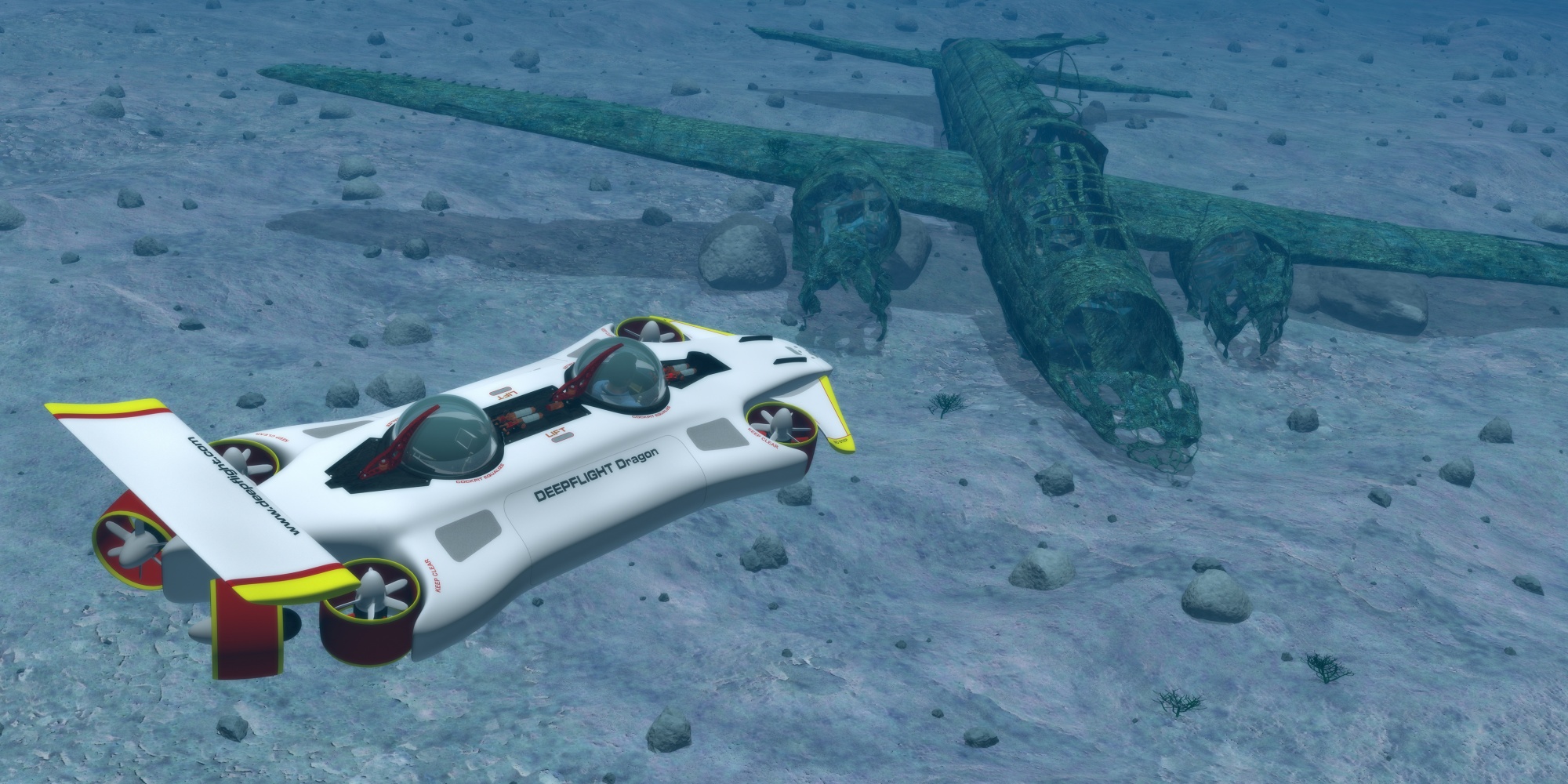
We may be overdue for an upgrade in the tech used to do underwater archaeology. Some new scuba or sub, possibly some new sensor. I don't know, it just seems that a crane, a net, and a bunch of divers is so 1950's.
Mike Grouchy
a reply to: mikegrouchy
Its probably one of the items lost when 'old' Alexandria slid into the sea from an earthquake.
Its probably one of the items lost when 'old' Alexandria slid into the sea from an earthquake.
The boat was invented the first time a log fell in the water and someone jumped on it. I'm sure that was a long time ago in the history of bi-pedal creatures on this planet.
originally posted by: mikegrouchy
I wonder what something like an 8,000 year old bronze age site in the English channel does to some of the migration theories, and something else. Who invented the boat. I've heard a lot of academic discussion about the wheel, but when was the boat "invented"/discovered. Sometimes I look at pictures like this sphinx and wonder if it didn't fall off a boat. How far back does that possibility go? The interesting thing about the 8,000 year old site is that it is a road.
Mike Grouchy
a reply to: mikegrouchy
unfortunately, the very nature of underwater archaeology is extremely cost and time prohibitive which is why we see so little of it. its a lot easier to walk around on land and survey a site than it is to do so underwater. Advances in radar, sonar and satellite tech are beginning to bridge the gap a little bit but its a very labor intensive and costly undertaking. Particularly when looking at paleolithic sites for example verses the recent Egyptian finds underwater. Unfortunately people get way more excited to go to a museum and see some cool looking AE artifacts that have been underwater for a couple thousand years as opposed to the scientific benefits of locating and exploring paleolithic sites that would give us greater insight into past migrations and habitats so that's where the money will almost always go. The bang for your buck always wins out sadly.
unfortunately, the very nature of underwater archaeology is extremely cost and time prohibitive which is why we see so little of it. its a lot easier to walk around on land and survey a site than it is to do so underwater. Advances in radar, sonar and satellite tech are beginning to bridge the gap a little bit but its a very labor intensive and costly undertaking. Particularly when looking at paleolithic sites for example verses the recent Egyptian finds underwater. Unfortunately people get way more excited to go to a museum and see some cool looking AE artifacts that have been underwater for a couple thousand years as opposed to the scientific benefits of locating and exploring paleolithic sites that would give us greater insight into past migrations and habitats so that's where the money will almost always go. The bang for your buck always wins out sadly.
new topics
-
President BIDEN's FBI Raided Donald Trump's Florida Home for OBAMA-NORTH KOREA Documents.
Political Conspiracies: 3 hours ago -
Maestro Benedetto
Literature: 5 hours ago -
Is AI Better Than the Hollywood Elite?
Movies: 5 hours ago -
Las Vegas UFO Spotting Teen Traumatized by Demon Creature in Backyard
Aliens and UFOs: 8 hours ago -
2024 Pigeon Forge Rod Run - On the Strip (Video made for you)
Automotive Discussion: 9 hours ago -
Gaza Terrorists Attack US Humanitarian Pier During Construction
Middle East Issues: 9 hours ago -
The functionality of boldening and italics is clunky and no post char limit warning?
ATS Freshman's Forum: 10 hours ago -
Meadows, Giuliani Among 11 Indicted in Arizona in Latest 2020 Election Subversion Case
Mainstream News: 11 hours ago -
Massachusetts Drag Queen Leads Young Kids in Free Palestine Chant
Social Issues and Civil Unrest: 11 hours ago
top topics
-
President BIDEN's FBI Raided Donald Trump's Florida Home for OBAMA-NORTH KOREA Documents.
Political Conspiracies: 3 hours ago, 23 flags -
Krystalnacht on today's most elite Universities?
Social Issues and Civil Unrest: 14 hours ago, 9 flags -
University of Texas Instantly Shuts Down Anti Israel Protests
Education and Media: 17 hours ago, 8 flags -
Weinstein's conviction overturned
Mainstream News: 13 hours ago, 8 flags -
Supreme Court Oral Arguments 4.25.2024 - Are PRESIDENTS IMMUNE From Later Being Prosecuted.
Above Politics: 14 hours ago, 8 flags -
Massachusetts Drag Queen Leads Young Kids in Free Palestine Chant
Social Issues and Civil Unrest: 11 hours ago, 7 flags -
Gaza Terrorists Attack US Humanitarian Pier During Construction
Middle East Issues: 9 hours ago, 7 flags -
Las Vegas UFO Spotting Teen Traumatized by Demon Creature in Backyard
Aliens and UFOs: 8 hours ago, 6 flags -
Meadows, Giuliani Among 11 Indicted in Arizona in Latest 2020 Election Subversion Case
Mainstream News: 11 hours ago, 5 flags -
2024 Pigeon Forge Rod Run - On the Strip (Video made for you)
Automotive Discussion: 9 hours ago, 4 flags
active topics
-
President BIDEN's FBI Raided Donald Trump's Florida Home for OBAMA-NORTH KOREA Documents.
Political Conspiracies • 12 • : WeMustCare -
Hate makes for strange bedfellows
US Political Madness • 47 • : 19Bones79 -
-@TH3WH17ERABB17- -Q- ---TIME TO SHOW THE WORLD--- -Part- --44--
Dissecting Disinformation • 689 • : daskakik -
University of Texas Instantly Shuts Down Anti Israel Protests
Education and Media • 265 • : Astrocometus -
Gaza Terrorists Attack US Humanitarian Pier During Construction
Middle East Issues • 27 • : ToneD -
Reason of the Existence
The Gray Area • 21 • : BingoMcGoof -
Supreme Court Oral Arguments 4.25.2024 - Are PRESIDENTS IMMUNE From Later Being Prosecuted.
Above Politics • 85 • : Sookiechacha -
Chris Christie Wishes Death Upon Trump and Ramaswamy
Politicians & People • 24 • : nugget1 -
New whistleblower Jason Sands speaks on Twitter Spaces last night.
Aliens and UFOs • 63 • : pianopraze -
SETI chief says US has no evidence for alien technology. 'And we never have'
Aliens and UFOs • 74 • : Justoneman

